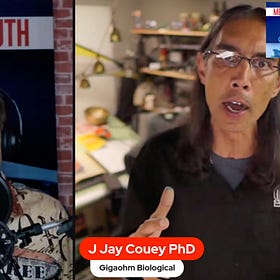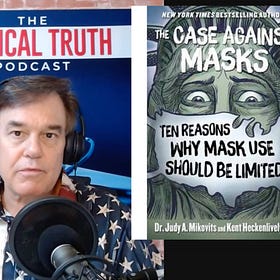An Immunologist Perspective on COVID (Part 1)
Watch now (50 mins) | In 2020, the world was blindsided by a pandemic that took the globe by storm. Media outlets bombarded the public with information and misinformation about COVID-19, mask mandates, PCR tests, social distancing, contact tracing, and the development of vaccines. Dr. J.J. Couey, a scientist and biologist, found himself at the center of these events. Fired from a major university and subsequently censored, he embarked on a journey to uncover the facts and challenge the prevailing narrative. In this blog post, we explore the conversations surrounding the pandemic, misinformation, and the pursuit of truth.
Mask and Vaccine Mandates a Sick and Twisted Game of Simon Says!!
Watch now (11 mins) | Welcome to the Medical Truth Podcast, your source for unbiased insights into the American healthcare system. I'm your host, James Egidio. Today, we delve into the swirling controversy surrounding the ever-evolving COVID-19 mandates. From mask-wearing to vaccine policies, we're here to uncover the truth behind the chaos.
(Part 2) An Immunologist Perspective on Vaccines
In this age of information, understanding complex topics such as vaccines and their mechanisms can be challenging. To help shed light on the intricate world of mRNA vaccines, we'll break down the science behind them and address some common misconceptions. Dr. J.J. Couey, a biologist with over two decades of experience, offers his insights in a recent interview on the Medical Truth Podcast. This blog post delves into the key points from that interview to help demystify mRNA vaccines.
The Basics of mRNA Technology:
Messenger RNA (mRNA) vaccines, like the ones developed to combat the COVID-19 pandemic, represent a novel approach to vaccine development. Dr. Couey starts by highlighting that mRNA technology itself isn't new; it has been used in academic research for about two decades. It's primarily a tool for manipulating genes and proteins in laboratory settings.
Transfection and Transformation:
To understand mRNA vaccines, you need to know about transfection and transformation. These techniques involve introducing genetic material (mRNA or DNA) into cells to alter gene expression or induce the production of specific proteins. In the context of academic research, scientists use these methods to study how genes influence cellular functions. It's worth noting that these techniques have been part of academic biology for quite some time.
The Role of mRNA in Vaccines:
Now, how does mRNA technology relate to vaccines? This is where the COVID-19 vaccines, such as those by Pfizer-BioNTech and Moderna, come into play. The mRNA in these vaccines doesn't directly alter your DNA, as some misconceptions suggest.
How mRNA Vaccines Work:
When you receive an mRNA vaccine, it contains a synthetic piece of mRNA that codes for the spike protein found on the surface of the SARS-CoV-2 virus, which causes COVID-19. Your cells read this mRNA and produce the spike protein. Your immune system recognizes this spike protein as foreign, producing antibodies against it.
Building Immunity:
The process primes your immune system to recognize and fight the spike protein. If you're later exposed to the actual virus, your immune system will be ready to respond, attacking the virus and preventing infection.
Debunking Misconceptions:
mRNA Vaccines Are Not Gene-Altering:
First and foremost, mRNA vaccines do not alter your DNA. They remain in the cytoplasm of your cells and don't enter the nucleus, where your DNA resides. The mRNA provides instructions for making the spike protein but doesn't interfere with your genetic code.
5G and Graphene Oxide Claims:
Some conspiracy theories suggest that mRNA vaccines contain elements like graphene oxide and are connected to 5G technology. Dr. Couey dismisses these claims as unfounded and part of a larger misinformation campaign. While some elements might have made their way into the narrative, there's no credible evidence to support these assertions.
The Concerns Raised by Dr. Couey:
Dr. Couey highlights several concerns related to mRNA vaccines, challenging some of the initial narratives presented to the public. Here are the key points he raises:
RNA Stability: While proponents of mRNA vaccines claim that the mRNA is relatively unstable, Dr. Couey points out that the actual data shows a different story. He notes that the mRNA in the vaccines may not be as unstable as initially portrayed.
Nanoparticle Toxicity: Dr. Couey suggests that the lipid nanoparticles used in the vaccines could have inherent toxicity when they congeal. This congealing might lead to unintended side effects.
Distributed RNA: During gel tests, researchers observed a smear pattern rather than a single clear band, indicating a wide range of RNA fragments. This suggests that only a portion of the injected RNA codes for the spike protein, potentially generating other viral protein fragments with unknown immune implications.
Intramuscular Injections: Dr. Couey questions the wisdom of administering the vaccine through intramuscular injections, suggesting it might not be the best method to stimulate a robust immune response. He believes it's a simplistic assumption to assume that muscle tissue is the ideal site for such vaccinations.
The Long-Term Concerns:
Dr. Couey's concerns extend to the long-term implications of mRNA vaccines. He suggests that these vaccines could lead to overstimulation of the immune system, potentially triggering autoimmune responses. Additionally, he raises questions about the vaccines' ability to penetrate the blood-brain barrier, potentially causing neurological issues.
Autoimmune responses and overstimulation of the immune system, as discussed by Dr. Couey, could potentially lead to unintended consequences, such as the activation of oncogenes, which are genes associated with the development of cancer.
The Final Thoughts:
The conversation with Dr. J.J. Couey offers a unique perspective on mRNA vaccines, highlighting complexities and concerns that have been discussed among medical professionals. While these concerns should be considered seriously, it's essential to remember that mRNA vaccines have undergone rigorous testing and have demonstrated their effectiveness in reducing the spread of COVID-19 and its severe outcomes.
As science continues to investigate the long-term impacts of mRNA vaccines, more insights will emerge. Public health experts, researchers, and medical professionals will continue to monitor the situation closely and provide guidance to ensure the safety and well-being of the population.
In conclusion, the world is navigating uncharted territory with mRNA vaccines, and the insights from experts like Dr. J.J. Couey remind us to remain vigilant, critical, and informed throughout this ongoing journey.













Share this post